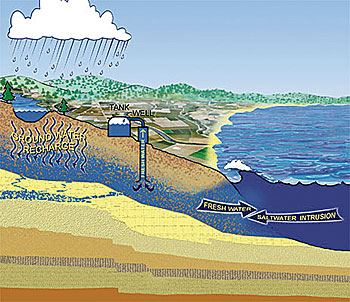Sustainable Solutions and Supplemental Water Supplies Major Issues for 2014
By Noel Smith

Mid-county water for public utilities and private well owners comes from the aquifers beneath us. There are no dams or reservoirs that supply our water for this part of the county; it all comes from wells pumping water out of the ground. Unfortunately, the ocean borders one side of this aquifer. If the fresh water from the aquifers are used faster than it can be replenished by rainfall or other recharging methods, salt water from the ocean starts to invade the aquifer. Eventually some wells may have to be capped because their water is no longer fresh and cannot be used as a water supply for either people or for agriculture.
Since 2007, the SqCWD and the Santa Cruz Water Department (SCWD) have explored the feasibility of using desalinated water from the ocean as a supplemental water supply. During the summer the plant’s water could be used by the SCWD to allow natural flow from the streams and the San Lorenzo River to support the wildlife including migrating fish species as they go upstream to spawn. During all other times, the output of a desalination plant could be used by the SqCWD to supply their customers and allow the groundwater supply to naturally recharge with winter rainfall and less groundwater pumping.
Now that the Desal project as a solution to supply this needed supplemental water for both water agencies has come under vigorous attack and may never happen, the search is on by the SqCWD to find other sources of water to take the pressure off and replenish their precious and limited water resource. The first meeting exploring other possibilities was held October 15 and presented the possibility of other sources of Desalinated water. (See Oct. 15 Aptos Times “Soquel Creek Water District Trying to Find a New Course”)
The Second meeting on November 5 looked at the possibilities of transferring surface water between other water agencies in the county. It was estimated that the infrastructure needed to transfer and treat the excess winter surface water would cost about as much as building the Desalination plant. Water rights were also identified as very complex, problematic, and long process.
The January 7 meeting explores mandatory water rationing as a potential solution. This option was initially developed in 2012 as a last resort plan and was conceptually designed to reduce overall water use by 35% for at least 20 years in the absence of a supplemental water supply solution. At this upcoming meeting, staff will present the original option as well as proposed modifications and discuss an approach to address concerns and further explore the feasibility of the mandatory water-rationing plan. The January 7 meeting, to be held at Capitola City Council Chambers (420 Capitola Avenue, Capitola), is open to the public and the District’s Board of Directors welcomes input.
Future topics in 2014 include discussion of recycled water options (February 4) and groundwater options (March 4). The District’s intent is to determine what is actually feasible and select a back-up option(s) to the joint scwd2 Regional Seawater Desalination Project should that project no longer be considered.
To help the district and its customers keep closer track of water usage, starting January 1, all SqCWD customers will be getting their bills on a monthly basis rather than every other month. Another program that is being put in effect is called the Water Smart Program. Customers will be informed about their water usage in comparison to other customers with similar family sizes in their neighborhoods. Another program the District implemented is mandating to save water is that all new construction must use 1.28 gpf (Gallons Per Flush) toilets. Also, 0.8 gpf toilets now available will be eligible for rebates.
•••
OUR AQUIFERS
Santa Margarita Basin: Made up of Lompico Sandstone, Butano Sandstone, Monterey Formation and the Santa Margarita Sandstone. Provides water to Scotts Valley, Lompico and San Lorenzo Valley.
Purisima: Provides water to Capitola, Live Oak, Soquel, and part of Aptos.
Aromas Red Sands: Provides water to Watsonville, Pajaro Valley, Corralitos, Larkin Valley, La Selva Beach, and part of Aptos.
Pajaro Valley Alluvium: This shallow aquifer used to be a major source of water for the Pajaro Valley until it became too contaminated with nitrates and salt to use for drinking water. It is separated from the Aromas Red Sands by a very thick layer of clay (50-150 feet thick).